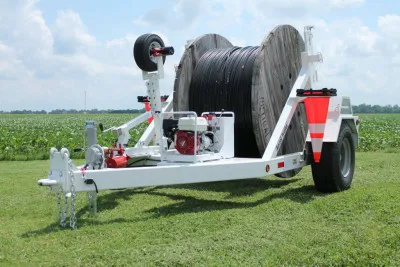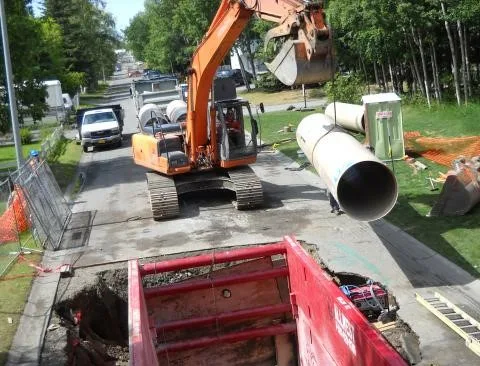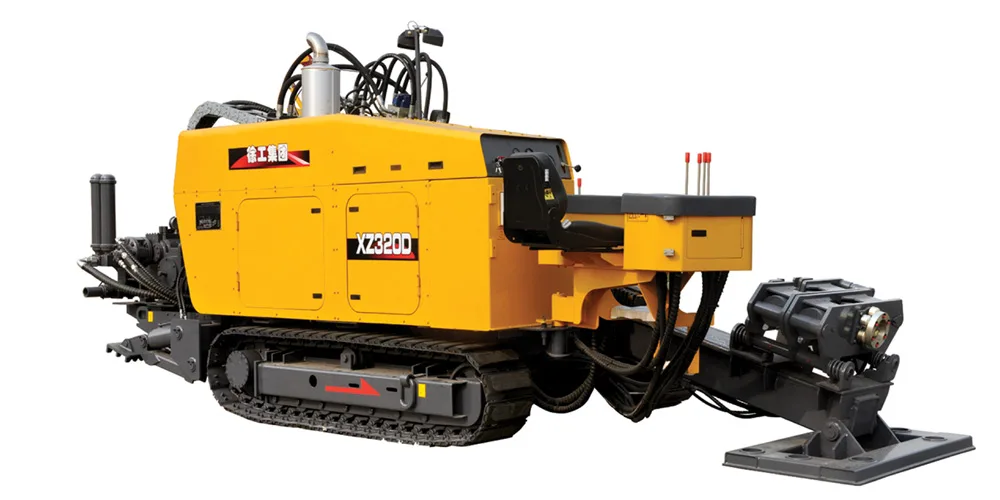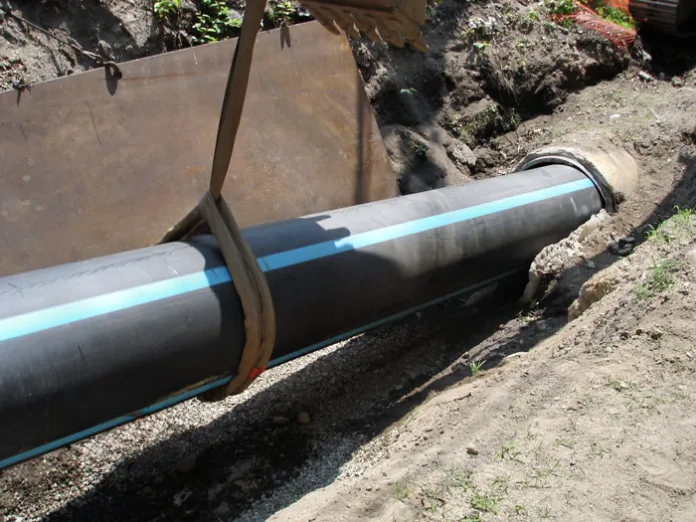Slip lining is a trenchless rehabilitation method used to restore damaged or deteriorating pipelines, without the need for excavation. This method involves inserting a smaller diameter pipe, typically made of polyethylene or PVC, into the existing pipeline, thereby creating a new and durable inner layer. It is a cost-effective solution that reduces disruption to infrastructure and extends the pipeline’s lifespan by preventing leaks and corrosion.
Where is Slip Lining used?
- Water and sewer system rehabilitation
- Industrial pipeline restoration
- Stormwater drainage repair
- Municipal utility infrastructure renewal
How does the Slip Lining Method work?
- Inspect and Clean: The existing pipeline is examined and cleaned to remove debris.
- Insert New Pipe: A smaller pipe is pushed or pulled into the old, damaged pipe.
- Grouting (Optional): Grout may be applied between the old and new pipes for added support.
- Reconnect: The new pipe is connected to the existing system.
- Testing and Restoration: The system is tested to ensure proper function, extending the pipeline’s life.
Advantages of Slip Lining
- Minimizes the need for extensive digging, preserving surface structures and landscapes.
- Generally more affordable than full pipe replacement due to lower labour and material costs.
- Allows for quicker project completion, minimizing downtime and service disruptions.
- Significantly extends the lifespan of existing pipelines through reinforcement.
- Effectively seals cracks and leaks, preventing contamination and loss of resources.
- Utilizes materials like HDPE or PVC that resist corrosion and deterioration.
- Smooth inner surfaces of the new pipe enhance fluid flow and reduce turbulence.
- Produces less waste and minimizes environmental disruption compared to traditional methods.
- Suitable for various pipe sizes, materials, and configurations.
- Ideal for urban settings, significantly reducing traffic interruptions during installation.
- Strengthens existing pipes, reducing the risk of future collapses or failures.
Different types of equipments used for Slip Lining



Hydraulic Pulling Equipment
Hydraulic pulling equipment is essential for the slip lining process, designed to exert the necessary force required to pull the liner through the existing pipeline. This equipment utilizes hydraulic power to provide precise control during installation, minimizing the risk of damaging the liner. Its ability to handle long, heavy liners makes it particularly beneficial for larger diameter pipes commonly found in municipal sewer and stormwater systems. The efficiency of hydraulic pulling equipment allows for a smooth installation process, ensuring the liner is properly positioned within the host pipe, which enhances the overall success of the project.
Pipe Launching Equipment
Pipe launching equipment is employed to facilitate the insertion of the liner into the host pipe. Typically equipped with hydraulic rams or jacking systems, this equipment provides a steady force that ensures the liner is pushed smoothly and accurately into place. One of its key features is the ability to align the liner correctly, which reduces the risk of misalignment or wrinkling during installation. The efficiency of pipe launching equipment makes it particularly effective in confined urban environments, where precision is paramount, contributing to minimal surface disruption and enhancing the overall effectiveness of slip lining projects.
Reel Trailers
Reel trailers are specifically designed for the transportation and unwinding of liners during the slip lining process. These trailers can hold long lengths of flexible liners and are equipped with hydraulic systems that enable controlled unwinding. An advantage of using reel trailers is their ability to deploy liners efficiently without tangles or damage. This equipment is particularly useful in municipal projects that require quick and accurate installation. The portability and ease of use of reel trailers streamline the slip lining process, ensuring that operations run smoothly from start to finish.
Hydraulic or Pneumatic Compressors
Hydraulic or pneumatic compressors play a significant role in the inflation of liners during the slip lining process. These compressors provide the necessary pressure to expand the liner, ensuring a tight fit against the interior walls of the host pipe. A notable feature of these systems is their rapid inflation capabilities, which help shorten installation time. The versatility of compressors allows them to adapt to various liner materials and conditions, making them suitable for different slip lining applications. By securely positioning the liner, hydraulic or pneumatic compressors enhance the overall performance and durability of the rehabilitation.
Excavators
Excavators are instrumental in preparing access points for the slip lining process. These heavy machines can dig entry and exit pits while also removing any overlying soil or concrete that may obstruct the pipeline. Equipped with various attachments, excavators can efficiently handle different site conditions. The versatility of excavators allows them to adapt to a range of tasks on the job site, making them valuable for minimizing disruption to surrounding areas while facilitating the slip lining operation. Their precise digging capabilities ensure that the process proceeds smoothly and efficiently.
Trenchless Installation Rigs
Trenchless installation rigs are specialized machines that streamline the slip lining process by combining multiple functions into one unit. These rigs can perform tasks such as pulling, pushing, and guiding the liner during installation, enhancing operational efficiency. One of the primary benefits of trenchless installation rigs is their ability to reduce project costs and timelines by minimizing the need for traditional excavation methods. Their versatility makes them well-suited for urban settings, where surface disruption needs to be kept to a minimum. By improving the effectiveness of the slip lining process, trenchless installation rigs contribute significantly to successful pipeline rehabilitation.
Liner Curing Equipment
Liner curing equipment is necessary for ensuring that the newly installed liner achieves optimal strength and durability. This equipment can include heat lamps, steam generators, or ultraviolet (UV) light systems designed to facilitate quick curing times. An important advantage of using curing equipment is its ability to enhance the adherence of the liner to the existing pipe, ensuring structural integrity over the long term. Efficient curing plays a key role in the success of the slip lining process, and the use of specialized equipment allows for faster project completion, thus minimizing downtime and restoring service more quickly.
Grouting Equipment
Grouting equipment is used to fill the annular space between the new liner and the existing pipe, which is essential for securing the liner and preventing movement or leakage. This equipment typically includes high-pressure pumps and mixing systems that ensure the grout is applied uniformly and effectively. The advantage of grouting equipment lies in its ability to enhance the structural integrity of the rehabilitated pipeline, providing additional support to the liner. Properly filling this space with grout ensures long-lasting performance, making grouting equipment an important component of the slip lining process.
Conclusion
Slip lining is an efficient trenchless method for rehabilitating ageing pipelines, providing minimal disruption, cost savings, and quicker project completion. As urban infrastructure continues to age, slip lining offers a sustainable solution for maintaining essential water and wastewater systems, making it an important option for municipalities and industries such as construction, utilities, and transportation facing increasing demands.


